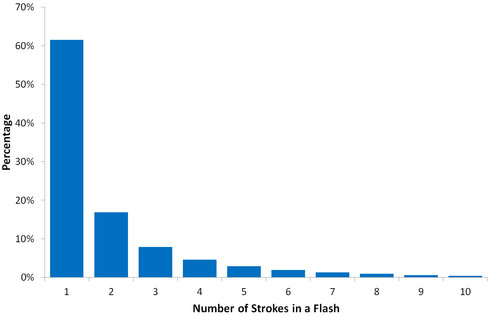Subsequent Strokes

In approximately 50 % of all lightning flashes to ground the first stroke is followed by one or more subsequent strokes, usually striking at the same point on the ground. The time interval between strokes in a flash is ranging from a few milliseconds (ms) to several 100 ms. A lightning flash with up to 20 or more strokes can exceed a total duration of more than one second. Flashes with a large number of subsequent strokes typically show a significant "flickering" of the lightning channel also seen with the naked eye.
The lightning detection system ALDIS locates each discharge (first stroke and subsequent strokes) completely independently. Based on a time criterion (e.g. all strokes within 1.5 seconds) and a spatial criterion (e.g. strike points within 10 km) strokes are grouped together to a flash in a post-process.
Recently conducted video studies of flashes using high-speed cameras have shown that between 30 % and 50 % of all flashes have more than one ground contact point. In most cases the ground strike point changes from one stroke to the next, i.e. when the leader of a subsequent stroke follows at the beginning the channel of the previous stroke, but then leaves this channel and finds its new path to ground and attaches at a distance of a few meters up to several kilometers.
Approximately 50 % of the negative flashes have at least one subsequent stroke. On average cloud-to-ground flashes have 3 to 5 strokes. Flashes with an unusually high number of subsequent strokes are typically flashes initiated from tall objects, so-called upward lightning.
Positive flashes are characterized not only by their higher amplitudes, they have also a relatively small average number of subsequent strokes. Rarely positive flashes are located with multiple strokes. The vast majority of positive lightning discharges are single stroke flashes.